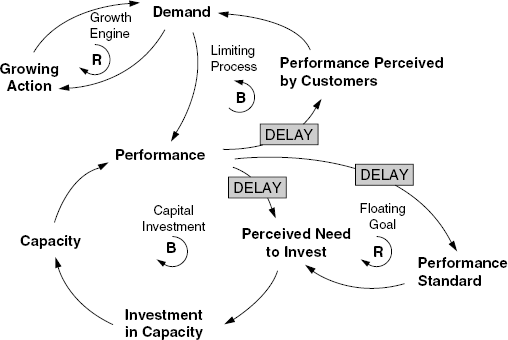Chapter 7. Managing Business Growth
Formulation Guidelines for Portraying Feedback Structure
An Information Feedback View of Management and Policy
Policy Structure and Formulations for Sales Growth
Policy Structure and Formulations for Limits to Sales Growth
Policy Structure and Formulations for Capital Investment
Simulation Experiments
Redesign of the Investment Policy
Policy Design, Growth and Dynamic Complexity
Conclusion
Appendix – Gain of a Reinforcing Loop
The limiting conditions on growth in the previous chapter were largely external to the firm or at least somewhat beyond the firm's control. However, some of the most interesting constraints on business growth are internal to the firm. They are self-imposed or self-induced limits that arise from the way that an organisation expands its resources in marketing, distribution and manufacturing. Specifically, managerial policies in different functional areas, though intended to stimulate growth, may instead create hidden conflicts that undermine growth and lead to premature stagnation or even decline in a promising market. This kind of self-fulfilling prophecy stems from a coordination problem known as 'growth and underinvestment', common in many firms and industries (Senge, 1990, Chapter 7).
Figure 7.1 shows typical feedback structure that lies behind growth and underinvestment. There are four interacting feedback loops, making this the most dynamically complex situation we have investigated so far. The terminology is deliberately broad in order to emphasise the generic nature of the loops. At the top of the figure is a reinforcing growth engine formed by the links between demand and growing action. The idea is that growing action by the firm (through expansion of marketing, salesforce, distribution channels, etc.) leads to increased demand that in turn justifies further expansion. On the right is a limiting process that depends on performance (of the product or service) in the market. Performance could mean service quality, availability, reliability, value for money, or any one of a number of factors that attracts customers. The important point is that such customer-facing performance depends on the balance between demand and capacity. If, for some reason, the firm's capacity to deliver and support a product or service falls short of demand then performance will decline, and eventually performance perceived by customers will fall too and therefore curtail demand. On the other hand, if there is adequate capacity then demand will continue to grow under the influence of the growth engine. Note in this case the limit to demand growth is not external and fixed (as in the diffusion models of Chapter 6) but is itself a part of the feedback structure and can vary accordingly.
Figure 7.1. Growth and underinvestment feedback structure

On the lower left of the figure is a balancing loop for capital investment. The loop connects performance, perceived need to invest, investment in capacity and capacity. This loop nurtures growth by ensuring there is always sufficient capacity to maintain satisfactory performance. However, appropriate investment is never easy to gauge. There is often ambiguity in investment plans and legitimate scope for differences of opinion in management teams about how much to invest and how soon. This ambiguity is captured in the concept 'perceived need to invest', which depends on performance relative to a performance standard. Performance below the standard is a signal to invest. If the performance standard were to be fixed and absolute then capacity adjustment would boil down to simple goal-seeking feedback, but there is an added sophistication, a subtle twist of dynamic complexity, in the form of a reinforcing loop called 'floating goal' that allows the goal itself to adapt. This loop, which is complementary to capital investment, connects performance to the performance standard, perceived need to invest, investment in capacity and capacity. If performance improves then, after a delay, the performance standard will improve too, leading eventually to more capacity, better performance and so on. The loop can operate as a virtuous or vicious cycle depending on the circumstances.
We will now discuss a model-supported, business case of growth that reveals a specific example of the growth and underinvestment archetype in action.
